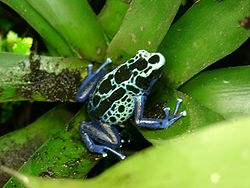| Image | Genus | Living species |
|---|
 | Adelphobates Grant, Frost, Caldwell, Gagliardo, Haddad, Kok, Means, Noonan, Schargel, and Wheeler, 2006 | |
 | Andinobates Twomey, Brown, Amézquita, and Mejía-Vargas, 2011 | - Andinobates abditus (Myers and Daly, 1976)
- Andinobates altobueyensis (Silverstone, 1975)
- Andinobates bombetes (Myers and Daly, 1980)
- Andinobates cassidyhornae (Amézquita et al., 2013)
- Andinobates claudiae (Jungfer, Lötters, and Jörgens, 2000)
- Andinobates daleswansoni (Rueda-Almonacid, Rada, Sánchez-Pacheco, Velásquez-Álvarez, and Quevedo-Gil, 2006)
- Andinobates dorisswansonae (Rueda-Almonacid, Rada, Sánchez-Pacheco, Velásquez-Álvarez, and Quevedo-Gil, 2006)
- Andinobates fulguritus (Silverstone, 1975)
- Andinobates geminisae (Batista et al., 2014)
- Andinobates minutus (Shreve, 1935)
- Andinobates opisthomelas (Boulenger, 1899)
- Andinobates tolimensis (Bernal-Bautista, Luna-Mora, Gallego, and Quevedo-Gil, 2007)
- Andinobates viridis (Myers and Daly, 1976)
- Andinobates virolinensis (Ruiz-Carranza and Ramírez-Pinilla, 1992)
|
 | Dendrobates Wagler, 1830 | |
 | Excidobates Twomey and Brown, 2008 | |
| Minyobates Myers, 1987 | |
 | Oophaga Bauer, 1994 | - Oophaga arborea(Myers, Daly, and Martínez, 1984) — Polkadot poison frog
- Oophaga granulifera(Taylor, 1958) — Granular poison frog
- Oophaga histrionica(Berthold, 1845) — Harlequin poison frog
- Oophaga lehmanni(Myers and Daly, 1976) — Lehmann's poison frog
- Oophaga occultator(Myers and Daly, 1976) — La Brea poison frog
- Oophaga pumilio(Schmidt, 1857) — Strawberry poison-dart frog
- Oophaga speciosa(Schmidt, 1857) — Splendid poison frog
- Oophaga sylvatica(Funkhouser, 1956) — Diablito poison frog
- Oophaga vicentei(Jungfer, Weygoldt, and Juraske, 1996) — Vicente's poison frog
|
 | Phyllobates Duméril and Bibron, 1841 | P. lugubris species group P. bicolor species group |
 | Ranitomeya Bauer, 1986 | - Ranitomeya aetherea Koch, Mônico, Dayrell, Ferreira, Dantas, Moravec, and Lima, 2025
- Ranitomeya amazonica (Schulte, 1999)
- Ranitomeya aquamarina Mônico, Koch, Dayrell, Moravec and Lima, 2025
- Ranitomeya benedicta Brown, Twomey, Pepper, and Sanchez-Rodriguez, 2008
- Ranitomeya cyanovittata Pérez-Peña, Chávez, Twomey, and Brown, 2010
- Ranitomeya defleri Twomey and Brown, 2009
- Ranitomeya fantastica (Boulenger, 1884)
- Ranitomeya flavovittata (Schulte, 1999)
- Ranitomeya imitator (Schulte, 1986)
- Ranitomeya reticulata (Boulenger, 1884)
- Ranitomeya sirensis (Aichinger, 1991)
- Ranitomeya summersi Brown, Twomey, Pepper, and Sanchez-Rodriguez, 2008
- Ranitomeya toraro Brown, Caldwell, Twomey, Melo-Sampaio, and Souza, 2011
- Ranitomeya uakarii (Brown, Schulte, and Summers, 2006)
- Ranitomeya vanzolinii (Myers, 1982)
- Ranitomeya variabilis (Zimmermann and Zimmermann, 1988)
- Ranitomeya ventrimaculata (Shreve, 1935)
- Ranitomeya yavaricola Pérez-Peña, Chávez, Twomey, and Brown, 2010
|
|







